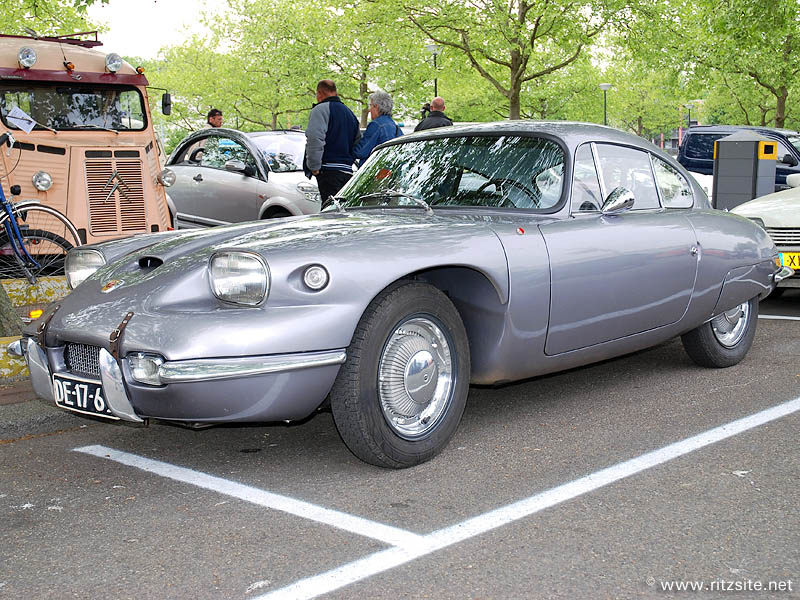|

Panhard CD Tourisme - coupe body - manufactured in 1963
The cars conceived by Charles Deutsch proved that there was a substitute for cubic inches: aerodynamics. This Frenchman, a civil engineer employed by the French government, was an autosport enthusiast and constructed his first racing car with his friend René Bonnet in 1938. After the war the two established themselves under the name Automobiles DB and made a range of racing- and sportscars, produced in very small numbers. Special about all these cars was that they were powered by very small production engines, usually not exceeding a displacement of 1 litre (61 cubic inch) and often even less than that. Still they were remarkably fast thanks to lightweight construction and advanced aerodynamic design.
From 1949 on Automobiles DB used only Panhard components and started to take part in the famous Le Mans 24 hours endurance races. It was in this event that Automobiles DB had their greatest successes; by the second half of the 1950s they were dominating the 750 cc class. But also in other important endurance races as the Sebring 12 hours in the USA and the Mille Miglia in Italy the DB racing cars were the main contenders for victory in the small capacity classes. Unfortunately the partnership between Deutsch and Bonnet came to an end in 1961 because Bonnet wanted to switch to Renault components while Deutsch remained loyal to Panhard.
One last Le Mans class victory came in 1962 for the car now named CD Panhard (after the initials of Charles Deutsch), which was leading the new car constructed by Bonnet. In the months following Deutsch created a beautiful streamlined coupe based on the Le Mans car which was marketed by Panhard as the Panhard CD in order to take advantage of the good name acquired by the Le Mans victory. It was introduced in 1963 and available in Tourisme and Rallye (for road races) versions. Both had the 2-cylinder Tigre boxer engine, fitted in a rigid but lightweight tubular chassis and complemented by a sleek fibreglass body. The tiny 848 cc (52 cubic inch) engine produced 60 hp @ 5750 rpm and hauled the 580 kg car to a maximum speed of 165 kph, or even 185 kph for the Rallye version. Astonishingly quick, even for today's standards; compare it to the 327 cubic inch (5358 cc) V8 of the 1963 Chevrolet Corvette for instance, which was good for a top speed of about 180 kph.
Even if it had both pedigree and proficiency the Panhard CD was too special to become a commercial success. It was only made for 2 years and about 180 of them were sold, including all versions. Charles Deutsch continued as an consultant in the automotive sector and also designed circuits. The Panhard CD became an instant classic and ended up in the hands of collectors and enthusiasts, that's why most of them have survived to this day. By some it's regarded as the ultimate Panhard, since this venerable French manufacturer disappeared from the market altogether in 1967.
For René Bonnet things went a bit differently: his Renault powered, mid-engined sport coupe named Djet was less extreme and had better prospects. Financial problems however lead him to sell his outfit to armaments manufacturer Matra in 1964. Matra continued production of small, light sportscars with production car technology under its own name until 1984. In 1965 René Bonnet retired from car manufacture and opened his own garage.
© André Ritzinger, Amsterdam, Holland
|
